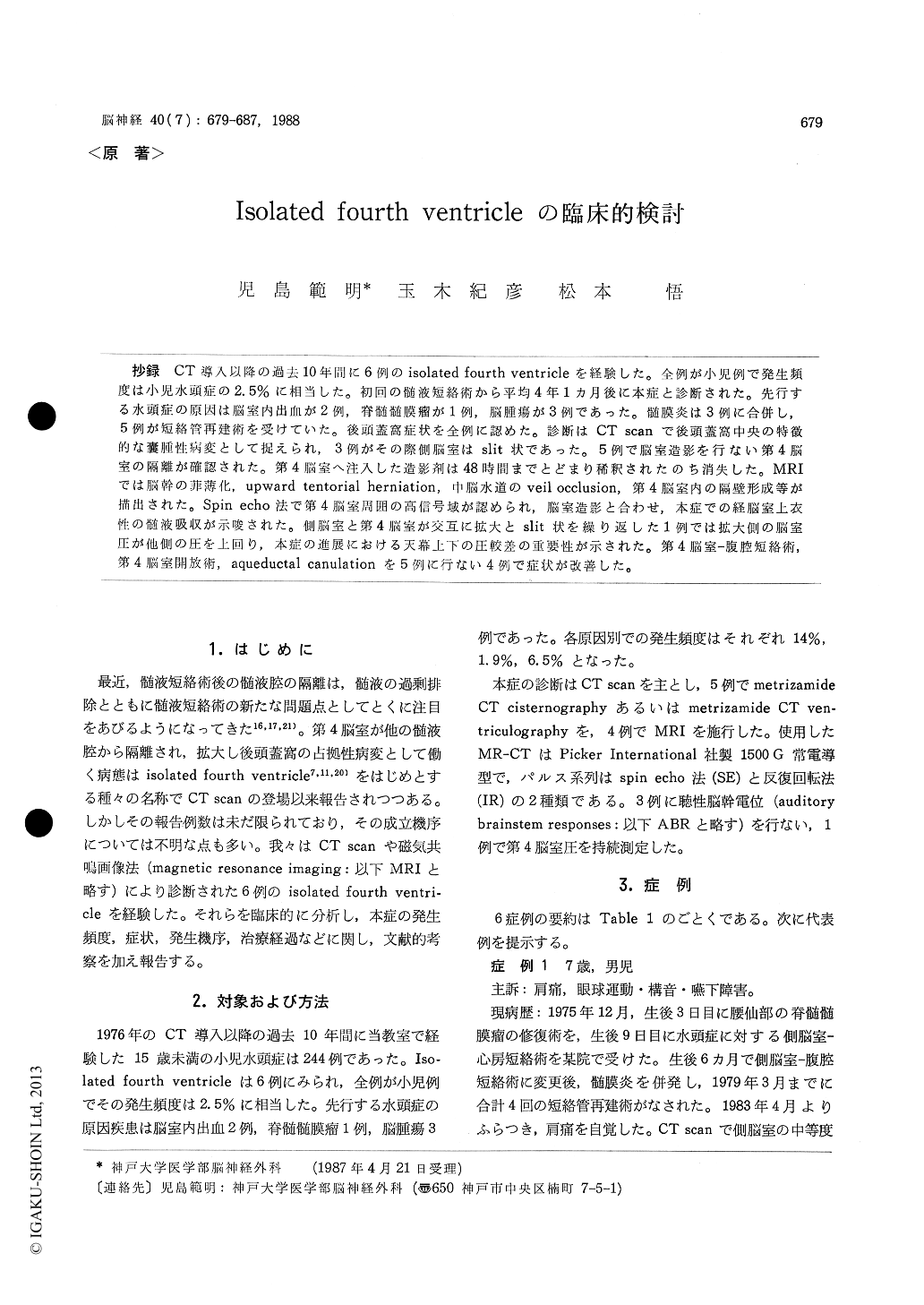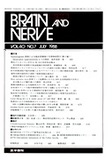Japanese
English
- 有料閲覧
- Abstract 文献概要
- 1ページ目 Look Inside
抄録 CT導入以降の過去10年間に6例のisolated fourth ventricleを経験した。全例が小児例で発生頻度は小児水頭症の2.5%に相当した。初回の髄液短絡術から平均4年1ヵ月後に本症と診断された。先行する水頭症の原因は脳室内出血が2例,脊髄髄膜瘤が1例,脳腫瘍が3例であった。髄膜炎は3例に合併し,5例が短絡管再建術を受けていた。後頭蓋窩症状を全例に認めた。診断はCT scanで後頭蓋窩中央の特徴的な嚢腫性病変として捉えられ,3例がその際側脳室はslit状であった。5例で脳室造影を行ない第4脳室の隔離が確認された。第4脳室へ注入した造影剤は48時間までとどまり稀釈されたのち消失した。MRIでは脳幹の菲薄化,upward tentorial herniation,中脳水道のveil occlusion,第4脳室内の隔壁形成等が描出された。Spin echo法で第4脳室周囲の高信号域が認められ,脳室造影と合わせ,本症での経脳室上衣性の髄液吸収が示唆された。側脳室と第4脳室が交互に拡大とslit状を繰り返した1例では拡大側の脳室圧が他側の圧を上回り,本症の進展における天幕上下の圧較差の重要性が示された。第4脳室—腹腔短絡術,第4脳室開放術,aqueductal canulationを5例に行ない4例で症状が改善した。
Since the introduction of the CT scan in 1976, we have experienced 6 cases of the isolated fourth ventricle among 244 hydrocephalic patients (2. 5%). Age at diagnosis of the isolated fourth ventricle ranged from 1 year 8 months to 13 years (mean age, 8 years 6 months). The time interval between the first shunting procedure and the diagnosis of the isolated fourth ventricle varied from 1 year 5 months to 7 years 4 months (mean interval, 4 years 1 months). The prior hydrocephalus were due to intraventricular hemorrhage in two patients, men-ingomyelocele in a patient and brain tumor in three patients. Two patients had history of cerebrospi-nal fluid (CSF) infection and five cases underwent multiple shunt revisions. Posterior fossa signs were evident in all cases. It was quite easy to make a diagnosis of the isolated fourth ventricle with CT scan, which demonstrated a large rounded or pear-shaped midline cyst in the posterior fossa. Slit-like lateral ventricles were noted in three cases, while the remaining three had enlarged lateral ventricles. Ventriculography confirmed the isolation of the fourth ventricle in 5 cases. Metrizamide which had been injected into the fourth ventricle was diluted when CT scan wasperformed 48 hours later, and contrast medium disappeared since then. Magnetic resonance ima-ging (MRI) well showed the characteristic findings of the isolated fourth ventricle : cystic dilatation of the fourth ventricle, compression and distortion of the brain stem, upward tentorial herniation, occlusion of the aqueduct, downward displacement of the occipital lobe, septum formation of the fourth ventricle and accompanied anomalies such as, Chiari malformation or syringomyelia. The spin-echo (SE) image revealed periventricular high signal intensity (PVHI) surrounding the fourth ventricle, which seemed to suggest the trans-ependymal absorption of the CSF, as well as the findings of the fourth ventriculography. There existed CSF pressure difference between supra-tentorial and infratentorial ventricles. This may be one of the major force in the progression of the isolated fourth ventricle. Five out of six cases received the fourth ventricular peritoneal shunt, fourth ventriculostomy, or aqueductal canulation. These operations produced relief of symptoms. However, encystment of the fourth ventricle re-curred in a patient one year after the fourth ven-triculostomy. The other patient showed chronic posterior fossa signs in spite of the functional fourth ventricular shunt.
(Received : April 21, 1987)

Copyright © 1988, Igaku-Shoin Ltd. All rights reserved.


